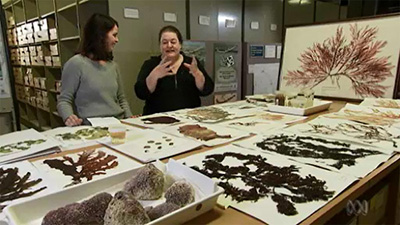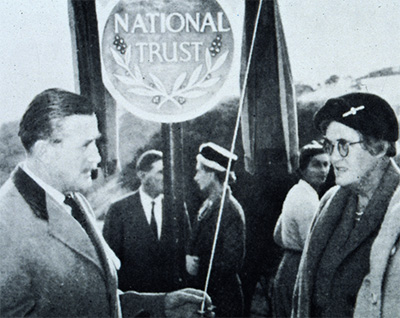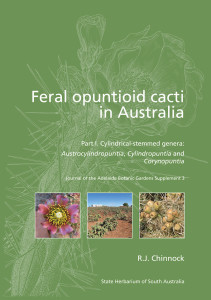State Herbarium of South Australia‘s Chief Botanist Michelle Waycott wrote an article for the online news portal The Conversation that was published today. In the article entitled “From Joseph Banks to big data, herbaria bring centuries-old science into the digital age” Michelle discusses herbaria and history, plant specimens and types, taxonomy and nomenclature, the Australasian Virtual Herbarium, molecular research and much more.
Category Archives: News
Landline report features the Herbarium
 On Monday, a report on ABC television’s Landline program on the potential for a seaweed industry in South Australia features an interview with Chief Botanist Michelle Waycott and several shots from the vaults of the State Herbarium of South Australia. A new document to the State Government recommends a multi-million dollar investment into a seaweed industry.
On Monday, a report on ABC television’s Landline program on the potential for a seaweed industry in South Australia features an interview with Chief Botanist Michelle Waycott and several shots from the vaults of the State Herbarium of South Australia. A new document to the State Government recommends a multi-million dollar investment into a seaweed industry.
See Michelle and the Herbarium at 2:20, 9:50, 11:10 and 19:30 mins.
Time travel with the Herbarium through newspapers

Plant presses over time. H.H. Finlayson’s parcel of plants for J.M.Black, 1934 (top). Ray Alcock’s travel press, 1970s (middle). A modern day press with nylon straps and metal mesh for the top and bottom (bottom).
One of the best and time-honoured ways to flatten and dry a plant specimen is to press it between the pages of newspaper — newspaper is durable, absorbent, dries quickly, is easy and cheap to come by and if kept dry lasts a very long time. Botanists have been using newspaper for pressing plants as their technique of choice for hundreds of years and continue to use it to this day (Qld Herbarium brochure, 3.4mb PDF).
Since the State Herbarium of South Australia opened in 1954, hundreds of thousands of plant specimens with their newspaper counterparts have been submitted to the collection (we have over a million specimens in our collection currently). Many specimens were even collected earlier than the official opening.
For example, the State Herbarium has six parcels of plants in its collections that were prepared by H.H. Finlayson in 1934 and identified by botanist John McConnell Black, the author of the first Flora of South Australia. The top photo on the right shows one of the parcels, still in the same condition, as when they were removed from the plant press, and neatly wrapped with twine. We are planning to unwrap them in the near future.
The State Herbarium also cares for artefacts from previous South Australian botanists, such as Ray Alcock’s travel press that he used in the 1970s. Charles Raymond Alcock was one of the State Herbarium’s prolific collectors. He turned his attention to plants, specifically weeds, in the 1950s. Plants and nature conservation became his passion until his death in 2015 (see orbituary in the ASBS Newsletter; 3.6mb PDF).
In most cases, when a plant specimen is filed into the collection it is mounted on archival paper, placed in archival folders and the newspaper originally holding the specimen is thrown away. However, sometimes the newspaper stays with the specimen, for instance there might be excess material that can be sent to other herbaria as duplicates, or it might be a long time between the collection being accepted and it finally being mounted. So naturally, when working with specimens, staff, volunteers and researchers from around the world come across old newspapers and on occasion have been known to take a moment for a good read.
 Being natural collectors and curators it is common for herbarium workers to save articles of interest for their own reference or general awareness. For example, Ray Alcock also kept a diary of newspaper clippings.
Being natural collectors and curators it is common for herbarium workers to save articles of interest for their own reference or general awareness. For example, Ray Alcock also kept a diary of newspaper clippings.
Here are a few examples of articles found in our Herbarium recently which we would like to share with you, in acknowledgment of History Month. Also to appreciate the inadvertent history held within the State Herbarium of South Australia and no doubt many other herbaria worldwide.
These first few articles are from the Adelaide Advertiser, between 1915 to 1917, some collected by Ray Alcock, focusing on issues such as climate change, agricultural prospects and even recruitment for soldiers in World War 1 (click on the image to enlarge).
These snapshots allow appreciation of the culture and literature at that time. The snippets also highlight an unusual role of our collections which include herbaria being custodians of many aspects of our history. These insights into the past, random and unintentional, but charming and informative, also make us aware of the important long term nature of collections, such as those in the State Herbarium.
As a resource for plant specimen collectors, the convenience of newspaper these days is becoming problematic, as social media and the internet take over. At times, the State Herbarium has run low on newspaper stock, since less people put them aside and donate. Although this isn’t of critical concern currently, eventually we will need to consider how to process plant pressings in the future.
Contributed by State Herbarium staff Chelsea Novice and Graham Bell.
Remembering Enid Robertson

The Governor of South Australia, Sir Robert George, unveils the National Trust plaque on Watiparinga Reserve, watched by the donor of the property Miss Alison Ashby. Photo: The Advertiser, 21 May 1959, SLSA +70984/76.
The well known botanist and conservationist Enid Robertson passed away last year. To commemorate her life and her dedication to the restoration and care of Watiparinga Reserve a new plaque will be unveiled this month, commemorating Enid and her aunt Alison Ashby.
The land, once part of the Ashby family’s Wittunga farm, was gifted to the National Trust by Alison Ashby in 1957. Watiparinga’s greybox grassy woodland provides an essential haven for rare and threatened plants and animals. Elsewhere, this habitat has largely been built over with housing and roads. A detailed booklet on this ecological community has been published by the Federal environment department (14.2mb PDF) a few years ago.
If you want to know more about Enid Robertson and her work, have a look at the transcript of an interview (1.2mb PDF) with her from the State Library of South Australia‘s oral history collection. Another family connection: her father Keith Ashby donated part of the family property to the Board of the Botanic Gardens and State Herbarium in 1965, which later became Wittunga Botanic Gardens.
World Book Day
World Book Day or World Books and Copyright Day is celebrated on 23 April every year and organised by UNESCO to promote reading, publishing and copyright. The 23rd of April was chosen, as the authors Cervantes, de la Vega and Shakespeare all died on this date. The day was first celebrated by the booksellers in Catalonia, Spain, in 1923. Since 1995 it is celebrated world-wide.
World Book Day is not well-known in Australia. Book Week, organised by the Children’s Book Council since 1945, is more popular and celebrated around the country in August each year.
 The Board of the Botanic Gardens and State Herbarium has issued a number of publications. A full list of reference and identification books on plants, algae and fungi can be found here, many of these publications are still available for purchase. The Board also holds copyright of all botanical texts issued by the Flora and Fauna of South Australia Handbooks Committee between 1922 and 1997 (see Zeidler 2002). Out-of-print publications have been scanned and are available for download on Enviro Data SA (click on the “All Reports” tab), for example Acacias of South Australia (64.3mb PDF), Orchids of South Australia (29.9mb PDF), or the six volumes of Womersley’s Marine Benthic Flora of Southern Australia (also available as species fact sheets).
The Board of the Botanic Gardens and State Herbarium has issued a number of publications. A full list of reference and identification books on plants, algae and fungi can be found here, many of these publications are still available for purchase. The Board also holds copyright of all botanical texts issued by the Flora and Fauna of South Australia Handbooks Committee between 1922 and 1997 (see Zeidler 2002). Out-of-print publications have been scanned and are available for download on Enviro Data SA (click on the “All Reports” tab), for example Acacias of South Australia (64.3mb PDF), Orchids of South Australia (29.9mb PDF), or the six volumes of Womersley’s Marine Benthic Flora of Southern Australia (also available as species fact sheets).
In addition, the State Herbarium of South Australia also publishes the new, 5th edition of the Flora of South Australia online in PDF format. The previous edition from 1986 is long in need of revision, as there are now over 1000 more plants known for the State. (Flora PDF files are also available here.)
 The last volume of the Journal of the Adelaide Botanic Gardens was received from the printer this week and is now being sent to our partner institutions and libraries. All articles in Vol. 29 (2015/16) are also available online, free of charge, on the journal’s web-page (flora.sa.gov.au/jabg). From this year, the journal changes its name to Swainsona, but continues the volume numbering. Vol. 30 of the renamed journal will contain the Proceedings of the Botany Symposium at the 2016 NRM Science Conference. Regular papers will be published in Vol. 31 (2017).
The last volume of the Journal of the Adelaide Botanic Gardens was received from the printer this week and is now being sent to our partner institutions and libraries. All articles in Vol. 29 (2015/16) are also available online, free of charge, on the journal’s web-page (flora.sa.gov.au/jabg). From this year, the journal changes its name to Swainsona, but continues the volume numbering. Vol. 30 of the renamed journal will contain the Proceedings of the Botany Symposium at the 2016 NRM Science Conference. Regular papers will be published in Vol. 31 (2017).
More information by the UN, UNESCO and Wikipedia on World Book Day. An order form for books published by the Board of the Botanic Gardens and State Herbarium is available here (270kb PDF). Orders can be placed by phone (08 8222 9311) or fax (08 8222 9399), or you email a scanned copy of this form to us (stateherbsa@sa.gov.au).








You must be logged in to post a comment.